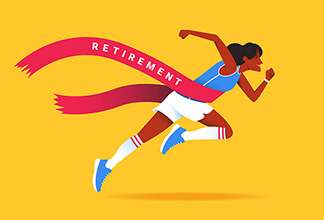Can You Trick Yourself Into Better Investing Decisions?
Written by Tamar Satov
Published on November 12, 2025
minute read
Share:
We all know people who continue to pay for a gym membership despite never putting it to use, or who keep their cable TV even though they don't watch any of the channels. (Heck, we might even be those people.) Why do otherwise intelligent folks throw their money away like this?
The answer is simple: It requires action to cancel a membership or subscription that is automatically billed every month, whereas it takes zero effort to stay the course and let the charges stack up. But don't put on your judgy pants just yet. Such behaviour isn't about laziness or irresponsibility.
Humans are predisposed to take the path of least resistance, due to what behavioural economists refer to as status quo bias. This is just one of many cognitive biases that can lead us to make poor choices in life — and in our investments. But you don't have to fall prey to your biases if you know how to deal with them.
“You can force yourself to take a step back and relook at things through a new lens,” says Kristen Duke, assistant professor of marketing at the University of Toronto's Rotman School of Management. “Ask yourself, If I were to make a decision over again at this point, what would I do?”
To help with decision-making – both inside and outside your portfolio – we looked into common cognitive biases and steps that you can take to trick our mind into level-headed thinking.
ANCHORING
Perhaps because our brains have to sort through so much data, we often use reference points to make valuations. The problem is that we can be overly swayed by the first piece of relevant information we get.
Say, for example, you've put your house on the market and your realtor says you'll probably get $500,000. If you get a solid offer at $450,000, you might be inclined to hold out for a (non-existent) buyer at half a million, because that figure became an anchor amount to which you compare all offers.
Investors are susceptible to this kind of thinking as well. “People can make anchor judgments based on how much they initially paid for an investment,” says Duke. That might lead them to hold on to a losing proposition for too long. “They might think, Ah, that's the value I want that stock to achieve again in the future. But that's just speculation. Once you own the stock, the initial price may no longer be relevant.”
Tricks to try: Consider looking at your portfolio as a whole, rather than focusing on individual stock prices. Create parameters to manage your portfolio. How are your assets allocated? Are you comfortable with the level of risk? You can also create alternate reference points by looking up new or additional information. In the case of anchoring to an initial stock price, for example, you might want to compare the stock's performance to other investments in the same industry or sector.
BANDWAGON EFFECT
Also known as herd mentality, this is the human tendency to follow the crowd — especially if we aren't sure what to do. While this “when in Rome” inclination can help us fit in and succeed in interpersonal situations, it doesn't work as well when applied to investing.
“Selling whatever everyone is selling or buying what everyone else is buying can lead to inefficient outcomes for you,” says Duke, who is also a research fellow at Behavioural Economics in Action at Rotman (BEAR). Indeed, most investing bubbles, such as the tech bubble of the late 1990s, occur because everyone is jumping on the bandwagon of a particular asset class. Unfortunately, bubbles are prone to burst.
Tricks to try: Look for reasons why the herd is moving in a given direction and determine if it's in your best interest to follow. “Ask, Why is this behaviour happening?” says Duke. “Is there any evidence that doing something opposite could help me?” It can be valuable to seek out other opinions, especially ones with a contrarian view, to help yourself see the pros and cons.
Also, consider whether the “bandwagon asset” even fits your risk profile.
CONFIRMATION BIAS
We like to believe that our own thinking is correct, which makes us highly attuned to information that confirms our views and inadvertently dismissive of anything that challenges them.
If, for instance, you strongly believe that a particular stock is a winner, any positive information you get about the company will reinforce your view, and you'll likely ignore any criticisms.
The result? You may overlook warning signs, or you might disregard potential opportunities.
Tricks to try: As with the bandwagon effect, seeking out contrarian opinions can help combat confirmation bias. On social media, make a point of following experts with opposing views and do your best to understand their perspectives.
EXCESSIVE OPTIMISM
We've all met people who seem to have an unrealistically rosy outlook, overestimating how often things will work out in their favour. While that attitude may help individuals weather the ups and downs of life, it doesn't help mitigate the ups and downs of the market.
This bias can be particularly pervasive after a long bull market, when investors forget that periodic downturns are normal. “People can start to think things will go especially well for them no matter what,” says Duke. But, it's important to remember that past performance doesn't guarantee future performance
Tricks to try: To mitigate against excessive optimism, strategies such as dollar-cost averaging and diversification may help if markets don't perform as you predict.
LOSS AVERSION
Humans experience the negative emotions of a loss to a greater extent than the positive feelings of an equivalent gain. As a result, we may overreact when there's a threat of a loss looming, behaving in risk-averse ways that don't always serve us well.
In evolutionary terms, this trait has likely kept us alive as a species. But when it comes to investing, avoiding all risk to protect yourself from potential losses might cost you. For example, loss aversion can lead young investors to be overly conservative in their portfolios and miss out on potential gains from taking a more aggressive approach, given that their long-term investments can have time to recover from market downturns. Conversely, someone who's taken on more risk than they're comfortable with may sell at the first sign of a downturn, locking in their losses.
Tricks to try: Review your comfort with risk regularly, particularly if you've had a life change that impacts your finances. Also, instead of thinking about potential losses or gains in abstract terms, look at how a loss or gain of five, 10 or 20 per cent would impact your portfolio's value.
“People's judgment of risk changes when you frame it differently,” says Duke, adding that 16.66 per cent can be perceived differently than a one-in-six chance, even though both express the same probability. A potential gain or loss of $30,000 on a $300,000 portfolio, for example, may strike you differently than a return of plus or minus 10 per cent.
OVERCONFIDENCE
Statistically speaking, only 50 per cent of people can be “better than average” at anything. Yet, in numerous surveys asking respondents about their driving abilities, far more than half consistently rate themselves above average. In other words, drivers have more confidence in their road skills than they should. Investors can also be prone to exaggerating their ability to predict the market or pick the right stocks.
Because of this overconfidence, investors may end up trading excessively, thinking they can “beat the market.”
Tricks to try: Get a reality check by comparing your returns with a benchmark, such as a broad stock-market index. If your returns are subpar, you may need to reassess your strategy.
PRESENT BIAS
Because the present moment feels vivid and visceral, we tend to give “the now” more weight than the future. “Most people would opt to have $10 right now, for instance, rather than $20 in a few weeks,” says Duke. Similarly, it's easier to commit to a future deprivation than one that starts immediately, as anyone who has pledged to start a diet — next Monday, not now — understands very well.
This preference for an immediate reward over a potential greater reward in the future can lead investors to focus on short-term rather than long-term goals, or even procrastinate on saving and investing altogether.
Tricks to try: Turns out, seeing an image of your older self can actually lessen your present bias because it makes you feel more connected to the person you will become. There are apps that can help you with this!
“There's some interesting work that shows connecting the current self to who you will be in the future reduces this strong preference for the present, and makes you more willing to share resources with your future self,” says Duke.
Consider how your mind might be playing tricks on you — and then kick those biases to the curb to help yourself make your best financial decisions.
This article was featured in our special issue, as seen in the Globe and Mail. Download the full magazine HERE.
RBC Direct Investing Inc. and Royal Bank of Canada are separate corporate entities which are affiliated. RBC Direct Investing Inc. is a wholly owned subsidiary of Royal Bank of Canada and is a Member of the Canadian Investment Regulatory Organization and the Canadian Investor Protection Fund. Royal Bank of Canada and certain of its issuers are related to RBC Direct Investing Inc. RBC Direct Investing Inc. does not provide investment advice or recommendations regarding the purchase or sale of any securities. Investors are responsible for their own investment decisions. RBC Direct Investing is a business name used by RBC Direct Investing Inc. ® / ™ Trademark(s) of Royal Bank of Canada. RBC and Royal Bank are registered trademarks of Royal Bank of Canada. Used under licence.
© Royal Bank of Canada 2025.
Any information, opinions or views provided in this document, including hyperlinks to the RBC Direct Investing Inc. website or the websites of its affiliates or third parties, are for your general information only, and are not intended to provide legal, investment, financial, accounting, tax or other professional advice. While information presented is believed to be factual and current, its accuracy is not guaranteed and it should not be regarded as a complete analysis of the subjects discussed. All expressions of opinion reflect the judgment of the author(s) as of the date of publication and are subject to change. No endorsement of any third parties or their advice, opinions, information, products or services is expressly given or implied by RBC Direct Investing Inc. or its affiliates. You should consult with your advisor before taking any action based upon the information contained in this document.
Furthermore, the products, services and securities referred to in this publication are only available in Canada and other jurisdictions where they may be legally offered for sale. Information available on the RBC Direct Investing website is intended for access by residents of Canada only, and should not be accessed from any jurisdiction outside Canada.
Explore More

Should I Invest or Pay Down My Mortgage?
Consider these four questions
minute read

As Many Head Back to the Office, Where Could Investors See Changes?
How returning to in-person work could affect a range of investments
minute read

Considering the FIRE Lifestyle? Here’s What Your Investments Might Look Like
We asked three people how they created financial independence and retired early
minute read
Inspired Investor brings you personal stories, timely information and expert insights to empower your investment decisions. Visit About Us to find out more.







